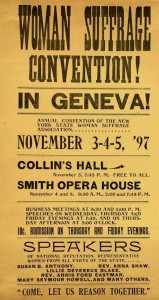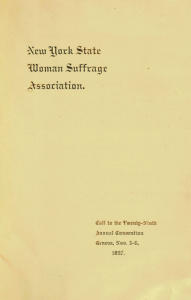SMITH HISTORY BLOG: “Come Let Us Reason Together”: Suffrage at The Smith, Part I
by Chris Woodworth
The Finger Lakes region boasts a rich and vibrant suffrage history. The 1848 Women’s Rights Convention held in Seneca Falls kicked off a multi-decade quest for obtaining the vote for women in the U.S. What may come as a surprise to readers not familiar with suffrage history is that Geneva, NY and The Smith Opera House played a pivotal role in the U.S. Suffrage campaign. Geneva became a hub for suffrage activity thanks largely to the political activism (and radical hospitality) of Elizabeth Smith Miller and her daughter Anne Fitzhugh Miller. Daughter of abolitionist Gerrit Smith and first cousin to Elizabeth Cady Stanton, it was no wonder that Elizabeth Smith Miller eventually found her way to political activism. According to Norman K. Dann in his book Ballots, Bloomers & Marmalade: the Life of Elizabeth Smith Miller, she preferred to work in the wings of the suffrage campaign, rather than take center stage with the oratorical prowess that her cousin Elizabeth Cady Stanton was known for. Yet Smith Miller was pivotal in her quieter role. Elizabeth Smith Miller and her daughter Anne documented their engagement in suffrage activism in a series of scrapbooks, which are now housed at the Library of Congress and fully digitized. These scrapbooks are not only a valuable resource for illustrating suffrage activism at the turn-of-the-century, they reveal the poignant role played by Geneva—and The Smith!—in this national campaign.

Broadside flyer advertising the 1897 New York State Woman Suffrage Convention, held at Collins Music Hall and The Smith Opera House. The broadside lists some of the speakers and events of the convention. At the bottom of the page is the invitation to “Come Let Us Reason Together.”
Elizabeth Smith Miller first made her activist mark in matters of women’s dress. Although Amelia Bloomer made famous “bloomers” or early pants for women, it was Elizabeth Smith Miller who first invented this new style of apparel (for more information on this, visit the Geneva Historical Society’s blog post, “Everything is Coming Up Bloomers!”). Elizabeth Smith Miller and her family moved to Geneva in 1869 to their home on Route 14, known as Lochland (currently the home of the Lochland School). Here, Smith Miller and her daughter hosted guests and gatherings, creating space for political and philosophical discussions. This was also extended to a camp across the lake, known as Fossenvue. It was at the Fossenvue site that Harriet May Mills, part of the leadership of the New York State Woman Suffrage Association visited Smith Miller and her daughter and urged them to host the annual New York State Suffrage convention later that year (Dann 162). This convention ignited a vibrant period of suffrage activism in Geneva, establishing it as a focal point for many prominent activists and speakers.
The Woman Suffrage Convention was held November 3 at Collins Music Hall and November 4-5 at The Smith. According to an article saved in the Smith Miller Scrapbooks (which they attribute to theGeneva Gazette November 5, 1897), The Smith was specially decorated with “yellow draping” hanging off the dress circle and various banners and flags (“Women Suffragists”). Among the speakers at this event was Susan B. Anthony. Although Anthony gave her main address at Collins Music Hall on the evening of the 3rd, according to the article detailing the events of the convention, she also spoke at The Smith as part of a response to committee reports and messages delivered from other organizations (“For Suffrage”). Rev. Anna Howard Shaw was also one of the highlighted speakers. Shaw would later go on to become president of the National American Woman Suffrage Association.

Cover of program from the 1897 New York State Woman Suffrage Convention, held at Collins Music Hall and The Smith Opera House.
The convention welcomed delegates from all over New York State and Genevans hosted them in their homes for the duration. Among those representing their communities was Harriet Tubman, who was then living in Auburn, NY. It bears mentioning that in the article that lists all of the delegates and their hosts, that every single name is preceded by Mrs., Miss, or Dr., with the exception of Tubman.* It is important to point out that while the races of all the other women listed are not known, it is a strong likelihood that they were all white women. The lack of honorific preceding Tubman’s name may perhaps illustrate the implicit (and often explicit) racism inherent to the U.S. suffrage campaign.
The 1897 Woman Suffrage Convention held in part at The Smith, was instrumental in the creation of The Geneva Political Equality Club. Officially founded a few weeks later, the first meeting was held November 30, 1897. According to Dann, that initial meeting, held at the YMCA boasted 50 charter members (165). It was under the auspices of the Geneva Political Equality Club that The Smith would welcome suffrage speakers several times throughout the years. Join us next week as we discuss the transatlantic connections between Geneva and two British suffrage icons, and how they each visited the Smith in both the twentieth and the twenty-first centuries!
*Special thanks goes out to Taylor Chapman, a former student of mine, for bringing attention to the way in which Harriet Tubman is addressed in this article and how racism was woven into the fabric of U.S. Society, even in social justice movements. As the U.S. gears up to celebrate the centennial of the 19thAmendment, not all women were granted equal access to the voting booth. Voting rights remained stripped from indigenous men and women and many Asian immigrants and restricted for African American women through exclusive, racist legislation. Louise Michelle Newman’s book, White Women’s Rights: The Racial Origins of Feminism in the United States (Oxford: Oxford University Press, 1999) offers a full account of this exclusion.
Works Cited
Dann, Norman K. Ballots, Bloomers & Marmalade: the Life of Elizabeth Smith Miller. Log Cabin Books, 2016.
“For Suffrage.” Miller, Elizabeth Smith, Anne Fitzhugh Miller, and National American Woman Suffrage Association Collectio. Scrapbooks of Elizabeth Smith Miller and Anne Fitzhugh Miller, to 1911, 1897. Online Text. Retrieved from the Library of Congress, www.loc.gov/item/93838336, Vol. 1, p. 9.
“Women Suffragists in Council in Geneva.” Miller, Elizabeth Smith, Anne Fitzhugh Miller, and National American Woman Suffrage Association Collectio. Scrapbooks of Elizabeth Smith Miller and Anne Fitzhugh Miller, to 1911, 1897. Online Text. Retrieved from the Library of Congress, www.loc.gov/item/93838336, Vol. 1, p. 8.